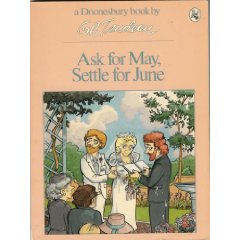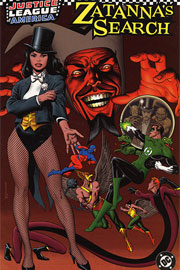 The Comics Reporter notes that today is the 61st birthday of Garry Trudeau, creator of the essential, still-vibrant Doonesbury. I don’t talk about comic strips as much as I probably should, but I’ve loved them longer than I’ve loved comic books, and Doonesbury is one of my all-time favorites.
The Comics Reporter notes that today is the 61st birthday of Garry Trudeau, creator of the essential, still-vibrant Doonesbury. I don’t talk about comic strips as much as I probably should, but I’ve loved them longer than I’ve loved comic books, and Doonesbury is one of my all-time favorites.
It’s hard to point to a specific Doonesbury collection, because all of them have something significant to recommend them. I’m disappointed to see how much of the Doonesbury catalog seems to be out of print. I remember a visit to my older sister’s house during my teen-aged years when I saw a neat row of slim Doonesbury paperbacks like Ask for May, Settle for June, As the Kid Goes for Broke, Do All Birders Have Bedroom Eyes, Dear? and lots of others.
The strip has always struck just the right blend of topical satire and ongoing, multi-generational soap opera for me. Trudeau can deal with challenging subjects – war, AIDS, divorce, unemployment, you name it – with grade, humor, and a wonderfully consistent tone. There’s really no such thing as a “very special Doonesbury.” They’re all pretty much special because of the affection and intelligence Trudeau applies, regardless of specific subject matter.
As I said, it’s said to me that there doesn’t seem to be a big, hulking Doonesbury collection that spans the strip’s history. The closest to that seems to be the Flashbacks: Twenty-Five Years of Doonesbury (Andres and McMeel), but it’s 15 years old and only 331 pages, so I’m not sure how comprehensive it can be. The publisher also lists it as “out of stock.” Why are some these great, ambitious strips so intermittently available in collected form?
 To persuade you, I’ll
To persuade you, I’ll  Never fear, though. DC has collected at least one example of Anderson drawing a second-tier, fishnet-wearing heroine in its
Never fear, though. DC has collected at least one example of Anderson drawing a second-tier, fishnet-wearing heroine in its 
